
 Bulldog Drummond (1941-49) aired “Hijackers” on September 28, 1941. This is only the sixth Drummond episode we have run, the first four presented in 2015, 2016, 2017, and 2018, respectively, with the fifth and last appearing over two years ago in early 2021, so it is high time we ran another of his adventures. If you like James Bond you’ll find a lot to like in Hugh “Bulldog” Drummond’s adventures. Bulldog Drummond was the character created by Englishman H. C. McNeile (1888-1937, photo at left, with the 1920 1st edition cover of his first book at right), who wrote under the pseudonym of “Sapper,” Sapper being the official term for those serving in the Royal Engineers during World War I, and the name suggested by McNeile’s publisher in order to lend the stories an air of authenticity. None other than Ian Fleming, creator of James Bond, wrote of Bulldog Drummond’s author that he was “Sapper from the waist up and Mickey Spillane below.”
Bulldog Drummond (1941-49) aired “Hijackers” on September 28, 1941. This is only the sixth Drummond episode we have run, the first four presented in 2015, 2016, 2017, and 2018, respectively, with the fifth and last appearing over two years ago in early 2021, so it is high time we ran another of his adventures. If you like James Bond you’ll find a lot to like in Hugh “Bulldog” Drummond’s adventures. Bulldog Drummond was the character created by Englishman H. C. McNeile (1888-1937, photo at left, with the 1920 1st edition cover of his first book at right), who wrote under the pseudonym of “Sapper,” Sapper being the official term for those serving in the Royal Engineers during World War I, and the name suggested by McNeile’s publisher in order to lend the stories an air of authenticity. None other than Ian Fleming, creator of James Bond, wrote of Bulldog Drummond’s author that he was “Sapper from the waist up and Mickey Spillane below.”
McNeile, who fought on the Western front in WWI and retired as a major in 1919, wrote a few stories during the war about Drummond as a detective but to no great success. With his first Drummond novel in 1920 (he would pen a total of ten until his death in 1937), Bulldog Drummond, Captain Hugh Drummond, DSO, MC, and ex-British army, was a detective no longer, but would become an adventurer bored with civilian life and, seeking excitement, would place an ad in the newspaper which read: “Demobilised officer, finding peace incredibly tedious, would welcome diversion. Legitimate, if possible, but crime, if of a comparatively humorous description, no objection. Excitement essential. Would be prepared to consider permanent job if suitably impressed by applicant for his services. Reply at once Box X10.”
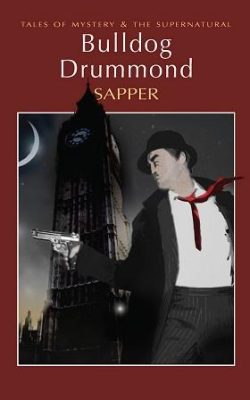 After rejecting the first few responses to his ad, Drummond accepts one from a distraught “damsel in distress” by the name of Phyllis Benton, whom he would end up marrying by the end of the novel. Phyllis’ problem, that for which she has enlisted Drummond’s aid, soon involves him in a deadly adventure with his soon-to-be recurring nemesis Carl Peterson, an evil genius and megalomaniac bent on world (and Communist) domination, his first conquest being Great Britain. The book is full of action and graphic violence, including a scene where a sociopathic torturer is shoved into an acid bath he has used on others. Not wishing to make certain he dies a quick death, Drummond allows him to throw himself out of the acid bath with his clothes smoking and his flesh bubbling and in agony, only to meet a terrible death a short while later. Sapper has Drummond pull no punches in his encounters with the truly evil. Through circumstance–and the bumbling police–Peterson escapes to commit evil another day, which he does for three more novels until his fitting demise.
After rejecting the first few responses to his ad, Drummond accepts one from a distraught “damsel in distress” by the name of Phyllis Benton, whom he would end up marrying by the end of the novel. Phyllis’ problem, that for which she has enlisted Drummond’s aid, soon involves him in a deadly adventure with his soon-to-be recurring nemesis Carl Peterson, an evil genius and megalomaniac bent on world (and Communist) domination, his first conquest being Great Britain. The book is full of action and graphic violence, including a scene where a sociopathic torturer is shoved into an acid bath he has used on others. Not wishing to make certain he dies a quick death, Drummond allows him to throw himself out of the acid bath with his clothes smoking and his flesh bubbling and in agony, only to meet a terrible death a short while later. Sapper has Drummond pull no punches in his encounters with the truly evil. Through circumstance–and the bumbling police–Peterson escapes to commit evil another day, which he does for three more novels until his fitting demise.
The third Bulldog Drummond novel, The Third Round (1924), gets into Bond territory (and SF) with some pseudo-science involved in the creation of synthetic diamonds. Arch nemesis, and identity-chameleon Peterson is back, whose only desire is to exploit the discovery. Sapper is getting the hang of how to write these books by this time, and it shows. These first four Drummond novels are known as the Carl Peterson Quartet, and are recommended for their action, plotting (in most cases), wild adventure, and a hero who knows good from evil, is smart, but hardly handsome, and is definitely a product of his time (that of post-WWI England, with its prejudices and views of those nations from which it has just emerged from a devastating war), and of Sapper himself, who puts much of his own military experience into the books, and surrounds Drummond with fictional army pals including his best friend Algy Longworth, his manservant James Denny (who you will hear in this radio episode), army buddy Peter Darrell, and other series regulars Toby Sinclair and Ted Jerningham. The Carl Peterson quartet of novels are collected in one volume by Wordsworth Editions (2007, 768 pp., though Amazon incorrectly has it at 320 pp., cover above right) and can be purchased via Amazon here.
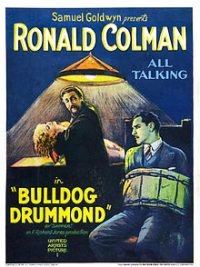 From the 1920s through the 1960s Bulldog Drummond was featured in 23 films. The first two (1922, 1925) were silent, but the third in 1929 with the eponymous title Bulldog Drummond starred Ronald Colman in his first talkie. The period of 1930-47 saw 17 Drummond films, a fair number including one of the famed Barrymore family, John, while Ray Milland would star in 1937’s Bulldog Drummond Escapes. The pair of Drummond films in 1948 would star no less than Tom Conway, and in 1951 Walter Pidgeon would star as Drummond in Calling Bulldog Drummond. An attempt to cash in on the James Bond movie craze in the 1960s saw two more Drummond films (Deadlier than the Male, 1967, and Some Girls Do, 1969), but with little success. The Bulldog Drummond character and adventures were so popular in Britain that in his early days while living in England, young up-and-coming film director Alfred Hitchcock sought the rights to the Drummond character for a film he was set to make titled Bulldog Drummond’s Baby. British International Pictures would not release the rights, so Hitchcock turned his film into the now classic The Man Who Knew Too Much (1934, starring Peter Lorre) without the Bulldog Drummond character. Hitchcock would remake the film in 1956 starring James Stewart and Doris Day.
From the 1920s through the 1960s Bulldog Drummond was featured in 23 films. The first two (1922, 1925) were silent, but the third in 1929 with the eponymous title Bulldog Drummond starred Ronald Colman in his first talkie. The period of 1930-47 saw 17 Drummond films, a fair number including one of the famed Barrymore family, John, while Ray Milland would star in 1937’s Bulldog Drummond Escapes. The pair of Drummond films in 1948 would star no less than Tom Conway, and in 1951 Walter Pidgeon would star as Drummond in Calling Bulldog Drummond. An attempt to cash in on the James Bond movie craze in the 1960s saw two more Drummond films (Deadlier than the Male, 1967, and Some Girls Do, 1969), but with little success. The Bulldog Drummond character and adventures were so popular in Britain that in his early days while living in England, young up-and-coming film director Alfred Hitchcock sought the rights to the Drummond character for a film he was set to make titled Bulldog Drummond’s Baby. British International Pictures would not release the rights, so Hitchcock turned his film into the now classic The Man Who Knew Too Much (1934, starring Peter Lorre) without the Bulldog Drummond character. Hitchcock would remake the film in 1956 starring James Stewart and Doris Day.
 1937-39 would prove arguably the best years for Bulldog Drummond films, when Paramount would make nine of the short B films, most running to around 60 minutes give or take. For anyone wishing to introduce themselves to these fun, suspenseful action forays I recommend picking up the 2006 Mill Creek Entertainment boxed set titled Mystery Classics. It’s one of those “100 Movie Pack” sets reasonably priced with some real gems (along with a few easily forgotten pictures), but including a majority of interesting, entertaining films including six Bulldog Drummond titles: Bulldog Drummond’s Revenge (1937), Bulldog Drummond Escapes (w/Ray Milland, 1937), Bulldog Drummond Comes Back (1937), Bulldog Drummond in Africa (1938), Bulldog Drummond’s Peril (1938), and Bulldog Drummond’s Secret Police (1939). These films stick pretty close (in general) to the original Drummond world as depicted in the novels, save for one striking departure; in the first novel, Bulldog Drummond (1920), Drummond marries Phyllis Benton, while in the movies he’s always about to be married–-just at the altar, as it were–-when something inevitably happens to postpone or otherwise thwart the ceremony, thus making poor dear Phyllis always the understanding, long-suffering bride-to-be whom Drummond is always promising to marry as soon as the current adventure is concluded. It’s a humorous bit replayed in several of the films, and the actress plays the bit to great advantage.
1937-39 would prove arguably the best years for Bulldog Drummond films, when Paramount would make nine of the short B films, most running to around 60 minutes give or take. For anyone wishing to introduce themselves to these fun, suspenseful action forays I recommend picking up the 2006 Mill Creek Entertainment boxed set titled Mystery Classics. It’s one of those “100 Movie Pack” sets reasonably priced with some real gems (along with a few easily forgotten pictures), but including a majority of interesting, entertaining films including six Bulldog Drummond titles: Bulldog Drummond’s Revenge (1937), Bulldog Drummond Escapes (w/Ray Milland, 1937), Bulldog Drummond Comes Back (1937), Bulldog Drummond in Africa (1938), Bulldog Drummond’s Peril (1938), and Bulldog Drummond’s Secret Police (1939). These films stick pretty close (in general) to the original Drummond world as depicted in the novels, save for one striking departure; in the first novel, Bulldog Drummond (1920), Drummond marries Phyllis Benton, while in the movies he’s always about to be married–-just at the altar, as it were–-when something inevitably happens to postpone or otherwise thwart the ceremony, thus making poor dear Phyllis always the understanding, long-suffering bride-to-be whom Drummond is always promising to marry as soon as the current adventure is concluded. It’s a humorous bit replayed in several of the films, and the actress plays the bit to great advantage.
The 1920s and 30s were the heyday of the Drummond novels and films, but American radio would catch up in the 1940s with the Bulldog Drummond radio series, where now Drummond has moved to the United States to continue his adventures, of which “Hijackers” is one. While the American radio incarnation of Bulldog Drummond is slightly watered down in terms of the graphic (and often extreme) violence appearing in the novels, this episode does of course, due to the nature of the subject matter, portray explicit violence. “Hijackers” would probably fall into the mold of a noir mob/gangster story if filmed, with Drummond and Denny counterparts to Eliot Ness in TV’s The Untouchables. Here the bad guys are indeed bad, ruthless and not averse to murder, forcing Drummond to come up with an unorthodox (but not entirely successful) plan to end their reign of terror. It’s all well done, a crackerjack example of noir radio, but this episode is also special in an unexpected way. You see, “Hijackers” was used as an audition episode, complete with a live test audience and recorded via closed-circuit only—not over the airwaves—to show potential advertisers what the show was all about, and to explain to them where their ads would be placed, how long they would be, and how many words a closing tease could be. So instead of pausing the story for a true ad, an announcer comes on explaining this is where the advertiser would place their first 1:30 ad, with suggestions on what it might contain to pique listener interest in their product. This pausing of the story and intrusion of the announcer takes place several more times, where it is also explained how the individual advertisers share of the ad cost would be pro-rated depending on how many markets bought ad space, with consideration for the size of the individual markets who would be carrying the program. It’s all very instructive and behind the scenes stuff and sets off the actual story quite effectively. So not only does the listener get a solid half hour of entertainment with “Hijackers,” but a lesson in how one model of the radio advertising business works as well. A twofer, for sure.
Play Time: 30:13
{“Hijackers” aired on a Sunday evening, so the neighborhood gang couldn’t wait to meet at the nearby newsstand the following afternoon to get caught up on some of their favorite SF pulps. Astonishing Stories (1940-43) hadn’t had an issue on the stands since April, so finding a new issue was quite a coup. Fred Pohl was the magazine’s first editor, and though he secured some top name talent ( Asimov and Heinlein and some of his other friends) at very low pay he was let go after the 9th issue (the one pictured below) and one Alden H. Norton took over as editor for the remaining 7 issues, though Pohl was retained as assistant editor. While some of the stories were surprisingly good, the low pay rate and the paper shortage during the war sealed the magazine’s fate. It managed 4 scattered issues in 1941. Astounding SF (1930–present, now Analog) was the field’s premiere SF magazine, and this issue only cemented this position among its fellow genre magazines for it would include Isaac Asimov’s soon-to-be classic story “Nightfall.” It was a monthly in 1941. Doc Savage (1933-49) was one of the more popular adventure/hero pulps, created to take advantage of the success of the same publisher’s The Shadow pulp. Doc was a scientist, doctor, adventurer, and polymath who, like many another hero-type would do everything he could to punish evil-doers. He was capably aided in his quests by his cadre of specialized companions: “Monk” Mayfair, an industrialist chemist, Brigadier General “Ham” Brooks, a lawyer, “Renny” Renwick, a construction engineer, “Long Tom” Roberts, an electrical engineer, and “Johnny” Littlejohn, an archaeologist and geologist. Doc’s adventures would take him and his “Fabulous Five” on dangerous missions around the globe, some small in scope and some dealing with intelligent but deviant-minded sociopaths rich in money but bankrupt in morals, out to conquer the world. Lester Dent would pen most of Doc’s 181 stories (under the house pen name of Kenneth Robeson), and it is no surprise to many of Doc’s ardent fans that he has become a cult hero in comics and film as well as in reprints of his magazine. Doc Savage (The Man of Bronze) was a monthly in 1941.}
[Left: Astonishing Stories, 9/41 – Center: Astounding SF, 9/41 – Right: Doc Savage, 9/41]
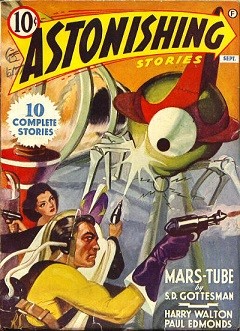
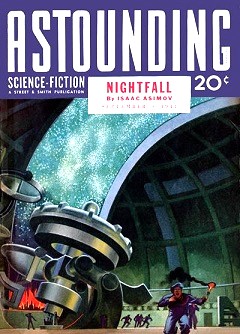
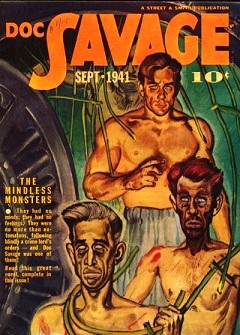
To view the entire list of weekly Old Time Radio episodes at Tangent Online, click here.